Description of the whitish talker
The whitish talker has other names as well. So, it is called a discolored, bleached, reddish, furrowed talker. If you come across one of these names in any literature, be aware that we are talking about the same fruit.

What does it look like
The mushroom has no special, specific appearance. It can be considered an ordinary white mushroom, which in large numbers settles in forests and plantings. However, this fruit is not as harmless as it seems at first glance. In order not to accidentally put such a specimen in a basket with a mushroom harvest, you need to know about its main features.
The structure and features of the species
The main characteristics by which you can recognize this instance are as follows:
- Hat. Reaches a diameter of 2-6 cm. In young specimens, it is convex, and its edges are noticeably tucked down. With age, the cap of the fetus becomes prostrate, and at the end of the life cycle, it acquires a concave or depressed shape. She often has waviness along the edges. The color of the cap section can vary from powdery white or whitish grayish to ocher. Light color is typical for young individuals, darker and more intense - for old fruits. If you look at the surface of the cap, you will notice that it is densely covered with a powdery coating, which can be easily removed. In wet weather, the skin of the cap becomes slimy, and on dry days it is shiny and silky. When completely dry, it begins to crack, brightens noticeably.
- The pulp can be called thin-fleshy. Its thickness on the disc of the cap part is only 3-4 mm. It is fibrous to the touch, its structure is elastic. The flesh is whitish in color, its color does not change on the cut. The smell is mealy. The mushroom has no expressive taste.
- Leg. Its length is about 2-4 cm, and its thickness is from 0.4 to 0.6 cm in diameter. Its shape is cylindrical; towards the base, the leg narrows noticeably. It can be completely straight or curved. In young mushrooms, the leg is solid, but over time, a cavity forms inside it. The leg surface is whitish or grayish in color, but in some places it is covered with spots of a nutty shade. If you press on it, it darkens.
Whitewashed talker belongs to lamellar mushrooms. Her plates are frequent, painted in a whitish color. As they mature, they take on a light yellow hue.
The spore powder is also white in color. The shape of the spores is ellipsoidal, their surface is smooth, and they themselves are colorless.
Edible or not?
Whitewashed Talker is an inedible mushroom. Moreover, it belongs to the category of poisonous, deadly fruits.
Remember! It is categorically not to be eaten, even a small dose of it can be fatal!
Whitish talker (Clitocybe rivulosa)
Furrowed talker
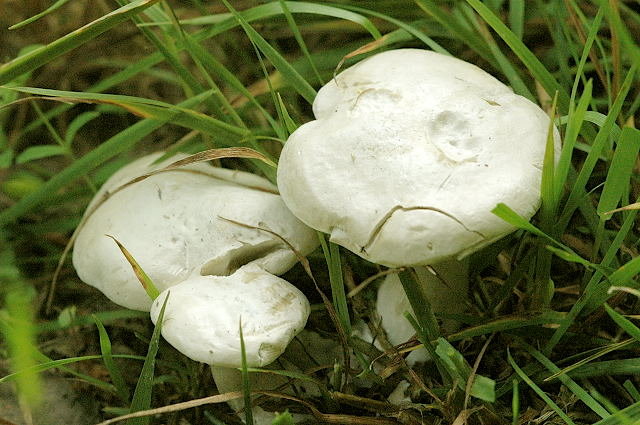
Whitish, bleached, or discolored (Latin Clitocybe dealbata), also reddish or furrowed (Clitocybe rivulosa) - a type of mushroom included in the Clitocybe genus of the Tricholomataceae family.
Whitish talker grows on soil or on a litter in places with a grass cover - in meadows and pastures or on forest edges, clearings and clearings in deciduous and mixed forests, as well as in parks. Fruiting bodies appear in groups, sometimes very large; form "witch circles". Distributed in the temperate zone of the Northern Hemisphere. The season is from mid-July to November.
The cap of the talker is whitish ∅ 2-6 cm, in young mushrooms it is convex, with a turned-up edge, later it is spread, in old mushrooms it is flat or depressed, often with a wavy edge. The color of the cap varies from powdery-white and whitish-grayish in young mushrooms to buffy in mature ones. Mature mushrooms have vague grayish spots on the cap.The surface of the cap is covered with a thin powdery coating, which can be easily removed; in wet weather it is slightly slimy, in dry weather it is silky and shiny; when dry, it cracks and becomes lighter.
The pulp is thin-fleshy (3-4 mm thick on the disc of the cap), elastic and fibrous, whitish, does not change color when cut. The taste is inexpressive; the smell is mealy.
The leg of the talker is whitish, 2-4 cm long and 0.4-0.6 cm ∅, cylindrical, slightly tapering towards the base, straight or curved, solid in young mushrooms, later hollow; the surface is whitish or grayish, in places covered with nut-colored spots, darkening when pressed, longitudinally fibrous. Plates are frequent, whitish, later grayish-whitish, at maturity acquire a light yellow color, descending to the pedicle, 2 - 5 mm wide. Spore powder is white. Spores 4–5.5 × 2–3 µm, ellipsoidal, smooth, colorless.
Deadly poisonous mushroom!
The content of muscarine in the whitish govorushka is higher than in the red fly agaric. Muscarine, contained in the fruiting bodies of the whitish talker (as well as in the fruiting bodies of related species, for example, Clitocybe phyllophila), can cause severe poisoning, which manifests itself 15-20 minutes after ingestion, increased secretion of saliva and tears, sweating, in large doses - a weakening of the heart rate, a sharp drop in blood pressure, respiratory failure, severe vomiting and diarrhea. Poisoning symptoms usually begin to subside after two hours. Fatalities are rare. The antidote for muscarine poisoning is atropine and other M-anticholinergics.
It grows on soil or litter in places with grass cover - in meadows and pastures or on forest edges, clearings and clearings in deciduous and mixed forests, as well as in parks. Fruiting bodies appear in groups, sometimes very large; form "witch circles". Distributed in the temperate zone of the Northern Hemisphere.
The season is from mid-July to November.
In the literature, two species are often distinguished - Clitocybe rivulosa with a pinkish cap and blades and a short stalk and Clitocybe dealbata with a grayish coloration and a longer stalk. These factors turned out to be insufficient for separation, the color of hygrophonic talkers depends significantly on the degree of wetting. Molecular genetic studies also came to the conclusion about one polymorphic species.

Talking mushrooms are edible and inedible, so when going into the forest, you need to clearly imagine what this or that variety looks like. If you are not completely sure about the nutritional characteristics, it is better not to put such mushrooms in your basket. Below you will find a photo and a description of a waxy, bent, orange, funnel, cracking, macefoot and other types of talker.
It is worth noting that most often only the caps are consumed in edible mushrooms, since the pulp of the leg has a low taste and a fibrous structure. In most cases, talker mushrooms are boiled and pickled.
Funnel talker - Clitocybe gibba
Written by Nikolay Budnik and Elena Meck.
The funnel-shaped talker is not often found on Ulom Zheleznaya. It is a small, skinny mushroom. The mushroom is edible. The taste is evaluated in different ways. Some mushroom pickers compare the taste with squid, others find the taste inexpressive. This mushroom is praised in pickle. You can salt it both hot and cold.
We do not collect the funnel-shaped talker. And we have not tried this mushroom either.
1. The funnel-shaped talker really looks like a small funnel.
2. In wet weather, the whole mushroom seems to shine through.
3.. dry - becomes dull.
4. The funnel-shaped talker appears at the end of June.
5. . and grows until September.
6. A mushroom is rarely found alone.
7. It usually grows in small groups.
8. Sometimes mushrooms are located randomly.
nine. . and sometimes - in slender rows.
10. It happens that the funnel talker grows in a damp pine forest.
eleven. . and sometimes - in drier places.
12.It can also be seen in a mixed pine-birch forest.
13. The fungus prefers sparse forest areas.
14. It is a small and thin mushroom in size.
15. This is the largest value that he reaches.
16. The funnel talker's hat is pink-flesh-colored.
17. There is usually a small, darker tubercle in the center of the cap.
18. If you look closely, you can see that the surface of the cap is covered with small scales.
19. The edge of the cap is thin and wavy.
20. Sometimes it becomes goblet.
21. This is how the cap is attached to the leg.
22. The plates can be almost white.
23. or pinkish.
24. They are quite frequent, even.
25. The plates descend far down the leg.
26. This is how they attach to the leg.
27. The foot of the funnel-shaped talker is straight and thin.
28. Usually it is painted in the same color as the records.
29. The leg expands downward, sometimes very significantly.
30. In old mushrooms, the leg is all soaked in water.
31. This is how the leg is attached to the ground.
32. Inside the leg is harsh, slightly spongy.
33. Sometimes it is hollow.
34. The flesh of the funnel-shaped talker is thin, not fleshy.
35. She is white, elastic.
36. This is how funnel talkers look like.
The 2017 film about the funnel-shaped talker
Talkers are whitish, whitish and reddish-brown
Whitish talker (Clitocybe candicans). The cap is 1.5–5 cm in diameter, initially convex, later flattened to a concave one, the edge is thin and lowered. The skin is slightly mealy at first, then shiny, smooth. The color is white, sometimes with a faint pink tint. The plates are frequent, weakly descending, white. The pulp is thin, white, the smell is expressionless, the taste is pleasant.
The leg is 2–4 cm high, up to 0.5 cm in diameter, cylindrical, often bent at the base, tomentose-pubescent. The color is white or yellowish.
Spore powder. White.
Habitat. In forests of different types on litter and needles.
Season. August - November.
Similarity. With other small white talkers, which should be refrained from collecting.
Use. The mushroom is suspicious, in different sources it is designated as poisonous, inedible, non-poisonous. According to some reports, it contains muscarine.
Whitish talker, whitewashed talker (Clitocybe dealbata). The cap is 2–4 cm in diameter, convex or flat, later funnel-shaped, often irregular in shape, with a winding, uneven edge. The skin is smooth, dry, with a light powdery bloom. The color is whitish, with faint grayish zones along the edge in the form of concentric circles formed by cracking of the plaque, at maturity with ocher spots. The plates are adherent or descending, white or grayish, then cream. The pulp is thin, white, the taste is expressionless, the smell is weak.
The leg is 2–4 cm high, up to 1 cm in diameter, cylindrical, slightly thickened towards the base, whitish or creamy, at first solid, later hollow.
Spore powder. White.
Habitat. In meadows, pastures, on forest grassy edges.
Season. Summer autumn.
Similarity. The mushroom is extremely similar to the willow (Clitopilus prunulus), which has a much stronger floury smell and in which the plates acquire a pinkish tinge at maturity.
Use. A very poisonous mushroom due to its high muscarine content.
Caution: in case of the slightest doubt, it is better to refuse to collect white talkers altogether.
Cracking Talker, Reddish Talker (Clitocybe rivulosa). The cap is 2–5 cm in diameter, initially convex, later spreads out, depressed in the center, covered with a powdery white bloom, which cracks as the cap grows, revealing the main color - cream or reddish-reddish. As a result, the surface is covered with vague concentric zones. The plates are adherent, frequent, reddish-white, later cream. The pulp is thin, the taste is expressionless, the smell is inexpressive.
The leg is 2–4 cm high, 0.4–0.8 cm in diameter, of the same color with the cap, or reddish brown, slightly tomentose at the base.
Spore powder. White.
Habitat.In forests, gardens, parks, often along paths, along the sides of ditches.
Season. From late summer to autumn.
Similarity. With other small white talkers, with edible willow (Clitopilus prunulus), which has a flour smell and pink plates.
Use. The mushroom is very poisonous.
Caution: do not collect small white talkers if you are not sure of the exact definition.
The talker is reddish-brown. The cap is 5–9 cm in diameter, wide-funnel-shaped, red-yellow, reddish-brown or rusty-spotted, often hygrophane. The plates are frequent, descending, cream or yellow-rusty. The pulp is thin, brittle, tough, reddish or pale yellow, sour smell, tart taste.
The leg is 3-5 cm high, up to 1 cm in diameter, reddish, lighter than the cap, tough.
Spore powder. White.
Habitat. In coniferous, less often deciduous forests.
Season. It is an autumn species that grows until frost-resistant.
Similarity. It looks like a water-spotted talker (C. gilva) growing in deciduous and coniferous forests, lighter colored and having watery spots on the surface; on the edible funnel-shaped govorushka (C. infundibuliformis), in which the plates are white.
Use. Previously, the red-brown talker and the water-spotted talker were considered edible, but later muscarine was found in them. The information in the literature about their edibility is very contradictory, moreover, their taste is mediocre, and therefore we do not recommend picking these mushrooms.
Look at the photo of the talker mushrooms, the description of which is presented on this page:
Large smooth bent talker in the photo
Rare edible mushroom Orange talker in the photo
Whitish talker in the photo
Inverted and aniseed talkers
Inverted talker (reverse lepist). The hat is 4-8 cm in diameter, as the fungus grows, it becomes wide-funnel-shaped, brick- or red-yellow-brown, fades over time, shiny in damp weather. The plates are frequent, descending to the stem, light yellow, then brown-yellow, sandy-buffy. The flesh is thin, grayish-yellow or pale yellow, light brownish, with a faint sour odor. The stem is tapered, elongated at the base, often curved, rigid, solid, then hollow, reddish, usually lighter than the cap, or rusty-brown. The inverted talker can be found in pine forests and plantings on coniferous litter, in mixed forests on litter. Fruit bodies form large groups in August - October.
Cooking. Insufficient edible mushroom. Suitable after boiling for salting. Some authors classify this mushroom as inedible.
Aniseed talker is an edible lamellar mushroom. Other names are fragrant talker and fragrant talker. A fairly rare mushroom that grows singly or in small groups from early August to late October, giving large yields annually. Most often it can be found in mixed and spruce forests.
When describing this talker, it is worth noting that its convex cap with the edges bent downward in the process of growth straightens and takes on a prostrate shape. In the center, it usually has a small depression, less often a tubercle. The cap is painted gray-green, lighter along the edge.
The spore-bearing layer contains adherent plates, whitish in young mushrooms, pale green in mature ones. The leg is rounded, wider at the base, grayish-yellow in color with a greenish tint. Its height is about 5 cm with a diameter of no more than 0.5 cm. The surface of the stem at the cap is smooth, slightly pubescent at the base. The flesh is thin, watery, pale green or off-white in color, with a strong smell of anise.
Aniseed talker belongs to the fourth category of mushrooms. It is eaten in boiled, salted or pickled form, and as a result of heat treatment, the characteristic smell of anise is significantly weakened and becomes not as pronounced as in fresh mushrooms.
Useful properties of hydrogen peroxide
Compound Н2О2 is found naturally in rain and melt water, in mountain air, in fruits and vegetables. Peroxide molecules are “incorporated” into the metabolic processes of living organisms and have a beneficial effect on them.
Useful properties of H2O2 solution for cucumbers and other garden crops:
- contributes to the saturation of the soil and plant tissues with oxygen when spraying, watering;
- neutralizes organic pollutants, improves the quality of tap and well water, making its composition close to natural precipitation;
- participates in the formation of immunity, influencing the release of the enzyme peroxidase;
- increases germination, stimulates seed germination;
- disrupts the vital activity of pathogenic organisms;
- improves respiration and photosynthesis of plants.
Waterproofing foundation walls
Protection of the walls from the ingress of capillary moisture is achieved by the device of horizontal gluing waterproofing at the level above the blind area, coating waterproofing of the vertical surfaces of the basement walls (technical underground) in contact with the ground and laying a greasy cement-sand mortar at the level of preparation under the basement floors (technical underground).
Perform horizontal waterproofing of 2 layers of waterproofing on bitumen mastic on a leveled surface along the entire perimeter of the outer and inner walls at a mark above the blind area (and above the snow that melts in spring).

Perform horizontal waterproofing from a layer of greasy cement mortar of 1: 2 composition and a thickness of 20 mm at the level below the basement floor.
The vertical waterproofing of the basement walls, porches, basement entrances in contact with the ground should be coated with hot bitumen in 2 times.
Shelf life and planting of treated seeds
After processing, the seeds are ready for planting. If the cucumbers are grown in a greenhouse, then the treated seed is planted in a day in prepared disinfected soil. If vegetables are planned to be grown in outdoor soil, then the treated seeds can only be planted in a germinated form, when they form sprouts. When the shell is closed, the grains may not open in unfavorable conditions and will die from the cold.
Processed grains are unsuitable for long-term storage, otherwise all the beneficial qualities of the procedure simply disappear. There is a risk of infection, germination worsens, and mold appears on the protective shell from soaking over time. In the future, this will negatively affect the development of vegetables.
Hydrogen peroxide is an inexpensive way to get quality seed without much effort. This method really works, and experienced summer residents continue to use it from year to year, which only proves its high efficiency. Pre-planting treatment should not be neglected, since this is one of the important stages of cultivation, which determines the health of future plants.
It is recommended to use this product as a top dressing for cut seedlings. This helps her to quickly take root in a new place, start active growth. Seedlings can be processed once every 7-10 days.
Correctly prepare seeds and feed seedlings
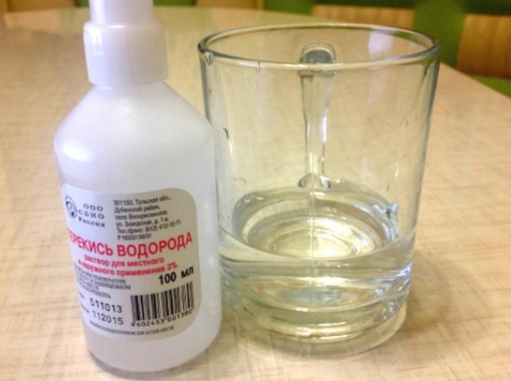 |
Disinfect planting material
Prepare a solution in a ratio of 1:10. 20 g of the composition is added to a glass of water, after which the liquid must be mixed well. Wrap the seeds in bandage or gauze to make it easier to remove them after processing. Dip in liquid and let stand for about 20 minutes. Remove and rinse seeds in warm water. You can dry them a little |
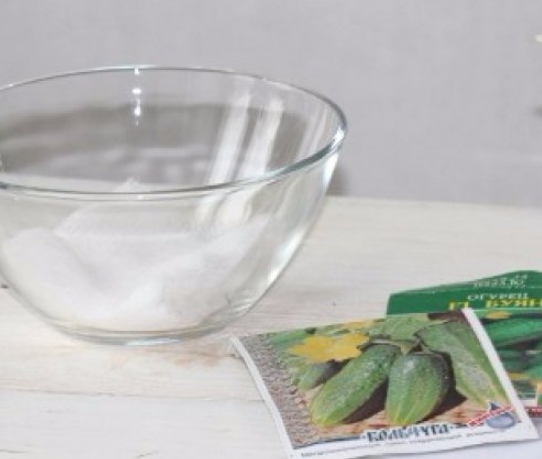 |
Soak to stimulate growth
When preparing a solution of a tablespoon of peroxide in a glass of water. Mix well and dip the seeds in cheesecloth or cloth. Soak for about 12 hours. After that, you can either sow the seeds, or place them in a container for further germination. |
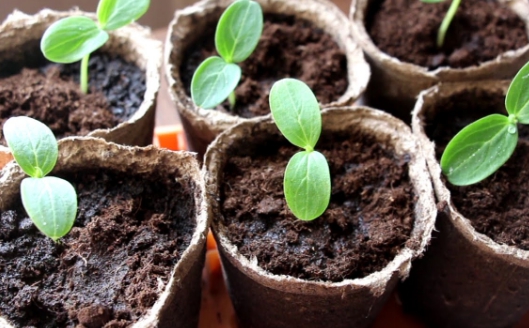 |
Spray about once a week
Prepare a solution at the rate of 30 ml of peroxide per liter of water. This is the optimal concentration for use on seedlings. Spray the ground part about once a week. Use a household spray to distribute moisture evenly over all leaves and stems |
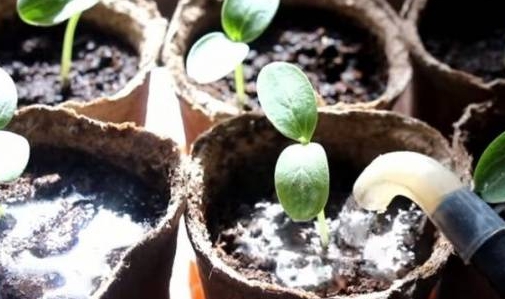 |
Water the seedlings with hydrogen peroxide solution
Prepare the solution in the same concentration as for spraying. Stir the liquid well and use it immediately after preparation. Carry out work no more than once a week. Replace regular watering, apply the same amount of water as usual |
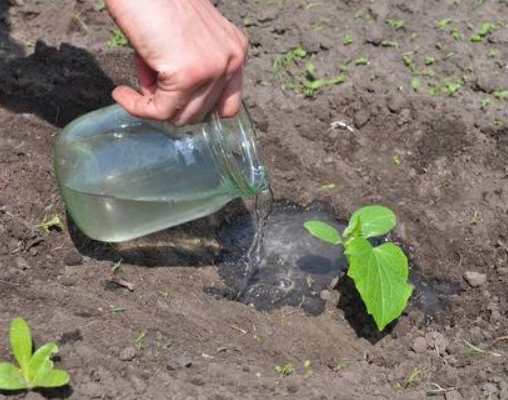 |
Water the seedlings immediately after planting
After planting cucumbers in a greenhouse or open ground, instead of water, it is better to water them with a solution of peroxide. Make 3% version before use. Pour at least a liter for each plant. This stimulates rapid adaptation and development of the root system. |
Prepare to soak cucumber seeds in hydrogen peroxide before planting. For this, preparatory actions are carried out:
- the seeds are pre-soaked in ordinary cool water for 30 minutes to soften the protective shell;
- dilute a working solution consisting of st.l. 3% solution of pharmacy peroxide and 500 ml of water.

You may be interested in:
Feature of the effect of hydrogen peroxide
Hydrogen peroxide (hydrogen peroxide) is a colorless substance with a "metallic" taste, which is of natural origin. It is found in atmospheric precipitation and is a by-product of the oxidation of various substances by air. Contained in mountain air.
The substance has a bactericidal effect due to its chemical properties. It easily reacts with oxidation, for example, with protein compounds, with the release of water. Reacts with other oxidants, it is a reducing agent, the reaction occurs with the release of atomic oxygen. At low concentrations, hydrogen peroxide is unstable and easily decomposes into water and oxygen molecules.
Benefit
How the beneficial effect of peroxide is manifested:
- due to the oxidative effect, it destroys the tissues of pathogens, pests on plants and in the soil;
- watering contributes to the aeration of the soil due to the instability of the substance;
- the quality of tap water improves, because reacts with organic matter, pesticides.
Methods for feeding cucumbers with hydrogen peroxide
The drug is introduced in two ways - by watering under the root and spraying the entire plant and the soil around it. On the question of how to breed peroxide for cucumber seedlings, the opinions of gardeners differ. Someone adds just a few drops per liter of water, while someone makes a more saturated solution. Most vegetable growers believe that the truth, as usual, is in the golden mean and add one or two tablespoons to one liter of water. Experience shows that this concentration does not spoil the plants and gives a good effect when growing cucumbers.
Watering is alternated with spraying, using the same concentration of the agent.
It is necessary to spray the seedlings on both sides of the leaf, and adjust the sprayer so that it forms the smallest fog that envelops the entire plant. Drops should not run off the leaves, so the treatment must be stopped in time, preventing this.
Water the cucumbers with a peroxide solution no more than twice a week. Plants that are actively growing and have not been transplanted for a long time respond especially well to such feeding. As you know, cucumbers have a weak root system located close to the soil surface, so it is problematic to loosen the soil under them.
Hydrogen peroxide can be used for other purposes as well:
- soil preparation;
- seed dressing and germination stimulation;
- watering plants.
The drug is used to prepare seeds for germination or planting. It is suitable for etching (used by analogy with potassium permanganate). To obtain the desired effect, they are placed in a 10% solution for 20 minutes.
The compound can stimulate seed germination. It is known that the inhibitors contained in them prevent germination.To neutralize, the seed is treated with a 1% solution of the substance. Some people advise keeping the seeds in this solution for 12 hours. There will be no harm, even if you make the concentration a little higher: the substance is not stable, and as a result of decomposition, water is formed.
Cucumbers are one of the favorite vegetables that can be eaten not only raw, but also canned for the winter. But in order to get a good harvest, you should take care of the plant, water it in a timely manner, eliminate weeds and carry out preventive work regarding the appearance of diseases. In order to avoid the death of plants, it is recommended to use hydrogen peroxide directly for cucumbers, since this solution is considered one of the best and safest remedies that can be applied to garden crops.
Since plants need rain or melt water for natural growth, peroxide in its composition provides an opportunity to replace them. To do this, you just need to dilute a small amount of the substance in ordinary water. One of the elements of this drug is atomic oxygen, which allows the soil to be saturated with this vital component.

Therefore, it can be used:
- Water the seedlings or simply spray the leaves with it. Thanks to this, they receive not only oxygen, but hydrogen peroxide also works as a fertilizer, which makes it possible for crops to grow well.
- By virtue of its properties, this drug is a disinfectant, therefore, such treatments are used to combat various diseases and pests.
- Experienced gardeners and gardeners use peroxide to germinate seeds. This helps to increase their germination and obtain a good harvest.
For a long time, hydrogen peroxide has been used as a fertilizer for irrigating any seedlings, as for cucumbers. This is due to the fact that plants are quite often exposed to various diseases, which negatively affects their growth and productivity. Thanks to this type of fertilizer, you can revive the plant, adding strength to it for further growth.






